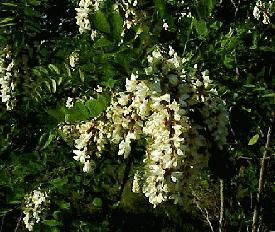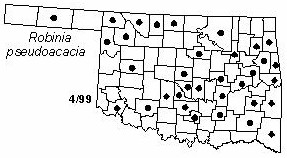
Tree to 15 m (50 ft) tall and 30 cm (1 ft) diameter, with an irregular open crown. Bark thick, gray, divided into long rough forking ridges. Twigs thick, brown, becoming glabrous, usually with paired sharp spines at the nodes. Buds very small, brown, hairy, in leaf scar, no terminal bud. Leaves alternate, pinnately compound, 15-30 cm (6-12 in) long. Leaflets 7-19, elliptical, almost sessile, 2.5-5 cm (1-2 in) long and 12-20 mm (0.5-0.8 in) wide, entire, rounded at end with a small bristle tip, dull blue-green above, pale green below, folding at night. Flowers numerous in drooping racemes 10-20 cm (0.4-0.8 in) long at base of leaves, fragrant, white, about 2 cm (0.8 in) long, blooming in late Spring. Fruits legumes, narrowly oblong, 5-10 cm (2-4 in) long and 2-3 cm (0.8-1.2 in) wide, dark brown, thin, maturing in Fall and remaining attached until splitting open in Winter.
Distribution: The native range is not accurately known, but may have been from the Ozark-Ouachita region to the southern Appalachians. The species is now found over much of the U. S.
Habitat: The native habitat seems to have been upland oak-hickory forests, but black locust seems to do well in many different habitats.
NWI status: FACU
Comment: Black locust has been widely planted as a shade tree, in shelterbelts, and in fuelwood plantations. It is fast-growing, tolerant of adverse conditions, and often escapes from cultivation. Robinia honors Jean and Vespasian Robin, Royal Herbalists of France, who first cultivated the locust tree in Europe; pseudoacacia refers to a resemblance to some species of Acacia.
Distribution in Oklahoma: 
BACK
NEXT
RETURN TO INDEX
Last update: 9/17/99
 Go to Oklahoma Biological Survey Home Page
Go to Oklahoma Biological Survey Home Page
 Disclaimer
Disclaimer